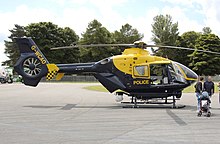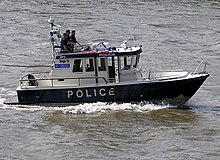User:Smilers/Sandbox

Police vehicles in the United Kingdom differ considerably depending on the duties that the vehicle is purchased to fulfil, along with the standard of training the driver has received. One of the most common police vehicles in the UK is the panda car which is often used in a community policing role[1]. Following an emergency call a response car would often be deployed to reach the scene quickly, with regards to public safety. If a vehicle fails to stop when requested by police officers, and enters into a pursuit a traffic car would often pursue in high capability vehicles such as the Volvo V70[2].
Ground vehicles
[edit]Most UK police vehicles are white or silver, although more recently silver becoming more common due to higher resale values after police use is finished, with retroreflective livery markings on the side. These markings usually take the form of a blue, yellow or red strip down the side of the vehicle, or use high visibility battenburg markings (with blue and yellow the accepted Home Office colours for police use).[3] Some carry adverts for police initiatives or slogans such as the Metropolitan Police "Working for a safer London", also some vehicles show the force crest.
Panda Cars
[edit]Panda cars, also known as beat, or general purpose cars, are used to aid in community policing, due to these vehicles being employed only for patrol. In some forces these vehicles are commonly low budget cars, and are not capable of speeding safely to get to an incident, but in others the only distinction between a panda car and a response car is the standard to which the driver is trained. Basic drivers driving panda cars may not be allowed to use all the emergency warning equipment on the vehicle.[1]
Response Cars
[edit]Incident response cars, also known as Area cars, are generally deployed when an emergency telephone call has been received about an ongoing incident or emergency. They often continually patrol a specific area to enable a fast response. Response vehicles tend to be high-capability vehicles, common types include the Ford Focus and Vauxhall Astra. These are usually fitted with engines with a size of around 1.6 to 1.8 litres. Although petrol-powered engines once dominated, diesel engines are now becoming more common due to their superior fuel economy and therefore lower operating costs.
Traffic Cars
[edit]Traffic cars, or Roads Policing Units, are larger, more powerful vehicles that are capable of carrying out tasks such as pursuing stolen cars, responding to emergencies in a larger area, or carrying a larger amount equipment than an response car. It is for that reason that many of the vehicles are in "estate car" form. These vehicles tend to be Volvo V70 T5's with a 2.4 litre turbocharged petrol engine or Vauxhall Vectras with 3.2 litre V6. As with IRVs, diesel engines are becoming more common such as the BMW 5 Series 3.0 litre diesel which are heavily used by the Metropolitan Police Service. As well as estate cars, 4x4 (SUVs) such as Range Rover, Land Rover Discovery, BMW X5 or Mercedes M class vehicles are used especially for Motorway patrols. Police Officers are required to undergo specialised training before being authorised to drive them. [2][4]
Unmarked police vehicles are often used on road policing duties. One popular vehicle for this use is the Skoda Octavia VRS which is chosen due to its high performance but conservative styling. Some police forces have begun using Mitsubishi Lancer Evolutions for the most dangerous or challenging car chases. The TVCU (Tactical Vehicle Crime Unit) within the Greater Manchester Police uses cars such as the Audi A3 3.2L Quattro, Mitsubishi Lancer Evolution, and Subaru Impreza WRX. All the TVCU's vehicles are unmarked and have very high performance.
Safe stop tactics
[edit]Tactical Pursuit And Containment (TPAC) is a term used by police in the United Kingdom, and describes training for managing and terminating police pursuits:
- Boxing - Several police cars position around the target vehicle, bringing it to a slow and safe stop, with police vehicles boxing the target vehicle in on all sides.[5]
- Spike strip - This method is employed if boxing would be difficult due to the speed or aggressive driving of the target vehicle. A hollow spike tyre deflation device is placed across the road in front of the target vehicle to deflate its tyres. This can safely stop even a fast moving vehicle, as the hollow spikes allow a controlled deflation to the tyres.[5]
- Tactical contact - This method is only used if there is an immediate danger to life, and if it would be inappropriate to break off the pursuit. Tactical contact involves a police car hitting the back end of the target vehicle, in the hope that it will spin around and lose traction.[5] It is similar to the PIT manoeuvre.
- Static stop - As a last resort, police cars can block off a road in the hope that it would force the vehicle to stop. This tactic requires authorisation from an officer of the rank Inspector or above, as it may cause damage to police vehicles and officers.[5]
- Road block - In extreme circumstances, an officer of ACPO rank may authorise the total closure of a road by placing immovable objects or non-police vehicles in the target vehicle's path, causing it to stop or change direction. This tactic is rarely used due to the risk involved.[5]
Armed Response Vehicles
[edit]In the UK most police officers do not carry firearms, so most forces use Armed Response Vehicles, or ARVs, to provide firearms support to spontaneous incidents throughout their force area. For this reason ARVs are often powerful vehicles like Volvo V70s, or larger vehicles like the Ford Galaxy which can carry large amounts of equipment[6] Some forces do not operate dedicated ARVs but instead use roads policing units that usually perform standard road policing tasks, but are also able to respond to firearms incidents.
ARVs are crewed by either two or three authorised firearms officers.
Other Vehicles
[edit]Police vans such as Ford's Transit or Mercedes Sprinter are also used and have a cage for accommodation of a prisoner in the back. Although in the United States it is possible to carry a prisoner or suspect in an ordinary police car, many forces do not permit this in the United Kingdom, as most police cars have no barrier between the front and back seats to protect the officers. Each police force will have different policies in relation to prisoner transportation, some will allow compliant prisoners to be transported in response cars (ensuring that one officer sits in the rear with the prisoner, and the prisoner sits behind the passenger seat). Non-compliant prisoners should always be transported in police vehicles fitted with a cage, some forces mandate all prisoners to be transported in caged vehicles.
Large vans, such as the Mercedes Sprinter, are also used by some forces as incident response that may act as a mobile control room at major incidents, and may also carry specialised equipment such as hydraulic door entry and cutting tools.[7]
Equipment
[edit]Area cars (that respond to incidents) and Panda cars (that are mainly used for community policing) may carry:
- First aid kit[4]
- Traffic cones[4]
- Fire extinguisher [4]
- Torch[4]
- Blankets[4]
- Shovel[4]
- Broom[4]
- Breath analysis system
- Speed gun
- Tyre Deflation Device (within Road Policing Units).[4]
- Teddy Bear (some RPU's carry them to console a child after an accident)
- Enforcer, entry gaining device
Most response and panda cars, are fitted with a "Runlock" system. This allows the vehicle's engine to be left running without the keys being in the ignition. This enables adequate power, without battery drain, to be supplied to the vehicle's equipment at the scene of a major incident. The vehicle can only be driven off after re-inserting the keys. If the keys are not re-inserted, the engine will switch off if the handbrake is disengaged or the footbrake is activated. Runlock is also commonly used when an officer is required to quickly decamp from a vehicle, by enabling Runlock, the cars engine can be left running without the risk of someone stealing the vehicle, due to the fact that if the vehicle is driven normally the vehicle will shut down, unless runlock system is turned off.
Warning Equipment
[edit]Under the Road Vehicle Lighting Regulations 1989 police vehicles may display blue flashing lights to alert other road users to their presence or when the driver feels that the journey needs to be undertaken urgently. Most police vehicles are also fitted with a siren. In addition to blue lights, many traffic and incident response cars are fitted with flashing red lights that are only visible at hte rear of hte vehicle. These indicate that the vehicle is stopped or moving slowly.[8]
Aircraft
[edit]
Most British police forces have access to an aircraft, commonly a helicopter. The most widely used helicopters are the EC 135 helicopter or the MD Explorer.
Police helicopters are fitted with an array of surveillance, navigation and communication technology to help them with a wide variety of tasks. The specific tasks that any one police helicopter performs will vary from force to force, but common deployments are for missing person searches, vehicle pursuits, the tracking of suspects, and maintaining public order.[9][10]
Some police helicopters are shared with the local air ambulance unit. In this case, a medically trained person may be carried onboard along with medical equipment and the aircraft will respond to medical emergencies as well as those of the police.[9]
Crew
[edit]The standard crew in a police helicopter consists of a pilot, responsible solely for operating and flying the aircraft; a front seat observer, responsible for operating the helicopter's surveillance systems; and a rear seat observer, responsible for communications using the tetra radio and downlink systems. Although both observers are often police officers, the pilot does not engage in any police activities and is usually not a police officer.[11]
Watercraft
[edit]
Police forces whose area includes significant waterways often include Marine Support Units. Not only do these units police the waterways, but they also maintain a capability for waterborne rescue, usually in cooperation with the RNLI.
Marine support units are most commonly known for their search capability, providing police divers to search for cars or bodies.
Also in sizable forces which police waterways, such as the Metropolitan Police Service who are responsible for the Thames River. Policing of such a waterway is important due to the risk of illegally imported drugs that enter the UK through the water network.
References
[edit]- ^ a b "LIMACHARLIE: Beat Patrol Car". Lancashire Constabulary. 2009.
- ^ a b "Road Policing". Greater Manchester Police. 2009.
- ^ "Police vehicle marking". Home Office Scientific Development Branch. 2009.
{{cite web}}: Text "Home Office" ignored (help) - ^ a b c d e f g h i "Vehicles and Equipment". Central Motorway Police Group. 2009.
- ^ a b c d e "GUIDELINES FOR THE MANAGEMENT OF POLICE PURSUITS 2004". ACPO. 2004.
- ^ "LIMACHARLIE: Armed Response Vehicle (ARV)". Lancashire Constabulary. 2009.
- ^ "Merseyside Police: About Us: Departments: Matrix Disruption Team". Merseyside Police. 2009.
- ^ "UK Emergency Vehicles > Information > Blue Light Use". UK Emergency Vehicles. 2009.
- ^ a b "What We Do". Western County Air Operations Unit. 2004.
- ^ "Metropolitan Police Service - Air Support Unit". Metropolitan Police Service. 2009.
- ^ "Metropolitan Police Service - Air Support Unit". Metropolitan Police Service. 2009.
External links
[edit]- Western Counties Police Helicopter Information Page
- United Kingdom Emergency Vehicles (mainly police)
- Private photographers collection
- Private collection
[[Category:Law enforcement in the United Kingdom]]
